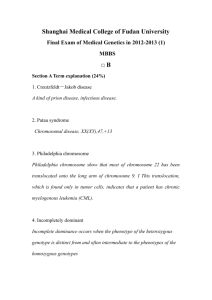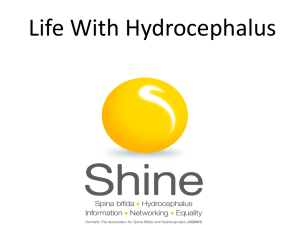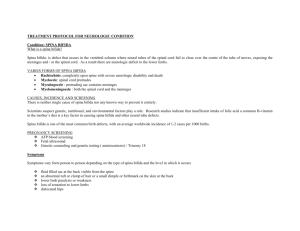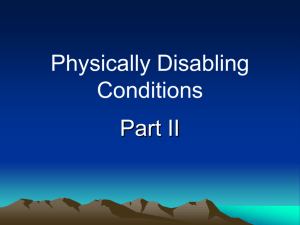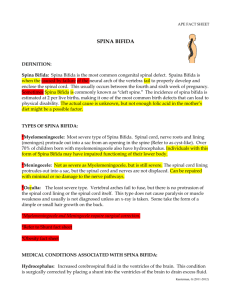educational issues
advertisement
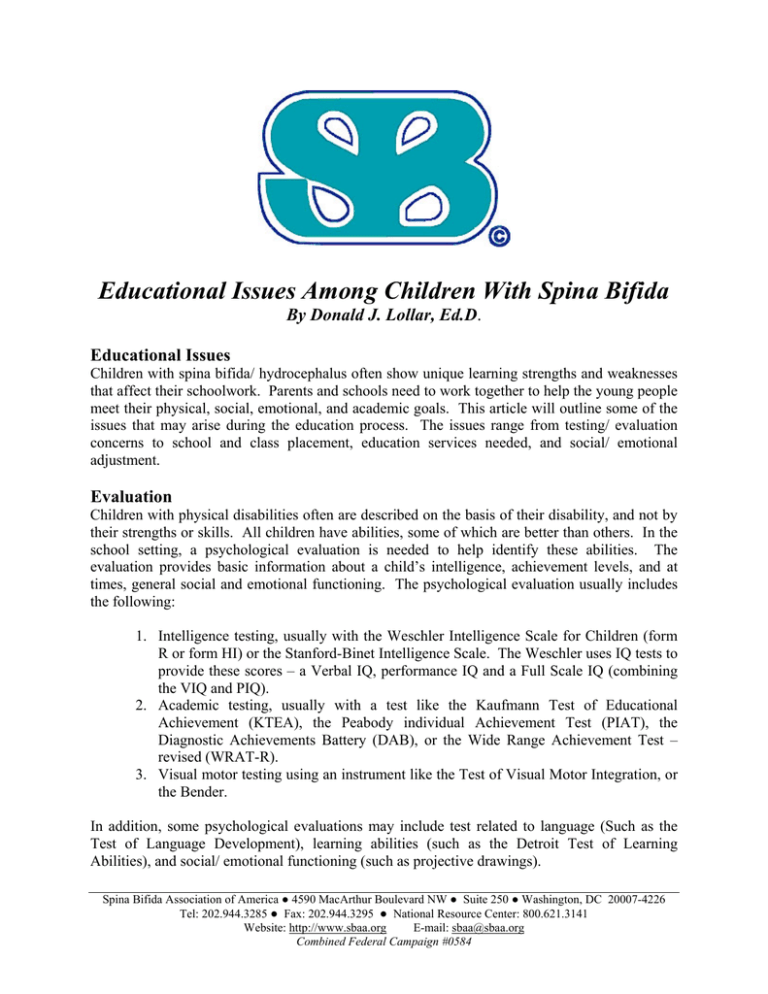
Educational Issues Among Children With Spina Bifida By Donald J. Lollar, Ed.D. Educational Issues Children with spina bifida/ hydrocephalus often show unique learning strengths and weaknesses that affect their schoolwork. Parents and schools need to work together to help the young people meet their physical, social, emotional, and academic goals. This article will outline some of the issues that may arise during the education process. The issues range from testing/ evaluation concerns to school and class placement, education services needed, and social/ emotional adjustment. Evaluation Children with physical disabilities often are described on the basis of their disability, and not by their strengths or skills. All children have abilities, some of which are better than others. In the school setting, a psychological evaluation is needed to help identify these abilities. The evaluation provides basic information about a child’s intelligence, achievement levels, and at times, general social and emotional functioning. The psychological evaluation usually includes the following: 1. Intelligence testing, usually with the Weschler Intelligence Scale for Children (form R or form HI) or the Stanford-Binet Intelligence Scale. The Weschler uses IQ tests to provide these scores – a Verbal IQ, performance IQ and a Full Scale IQ (combining the VIQ and PIQ). 2. Academic testing, usually with a test like the Kaufmann Test of Educational Achievement (KTEA), the Peabody individual Achievement Test (PIAT), the Diagnostic Achievements Battery (DAB), or the Wide Range Achievement Test – revised (WRAT-R). 3. Visual motor testing using an instrument like the Test of Visual Motor Integration, or the Bender. In addition, some psychological evaluations may include test related to language (Such as the Test of Language Development), learning abilities (such as the Detroit Test of Learning Abilities), and social/ emotional functioning (such as projective drawings). Spina Bifida Association of America ● 4590 MacArthur Boulevard NW ● Suite 250 ● Washington, DC 20007-4226 Tel: 202.944.3285 ● Fax: 202.944.3295 ● National Resource Center: 800.621.3141 Website: http://www.sbaa.org E-mail: sbaa@sbaa.org Combined Federal Campaign #0584 Some parents and professionals believe that the psychological evaluations are not helpful to their children, since their children are being compared with children who do not have disabilities. But state and federal guidelines require these evaluations for special services. Research studies provide data specifically related to children with spina bifida/ hydrocephalus. This research has provided information that can be used by parents and professionals to help children find appropriate placement and services. Initially, it is important to understand the common ideas about the learning and intellectual levels of children with spina bifida/ hydrocephalus accumulated over the past 20 years. Most of this literature relates the physical aspects of spina bifida/ hydrocephalus to intelligence and learning. The studies include research from several continents and reveal these trends: 1. Most children with spina bifida/ hydrocephalus have I.Q. scores in the average range. This result, however, is somewhat deceptive because there is a broad range of scores on intelligence test among children with spina bifida/ hydrocephalus ranging from the gifted to the retarded. Also, children with spina bifida/ hydrocephalus often have major differences among their abilities due to orthopedic and neurological problems. 2. Verbal (word) skills and intelligence are usually higher, often significantly so, than nonverbal (Performance) skills. 3. Children with spina bifida/ hydrocephalus often have poor perceptual-motor (nonverbal) abilities, which affect their eye-hand coordination. This can create problems at school with handwriting and other motor activities. 4. Academically, reading and spelling are usually higher, while math skills are often much lower. 5. Verbal I.Q. scores are better at predicting educational achievement than performance or Full Scale I.Q., when using a test like the Weschler Intelligence Scale for Children – III. 6. The higher the level at which the spinal cord is affected, the greater the possibility that intelligence and academic skills will be lower. Also, more severe hydrocephalus is associated with lower intelligence scores. 7. In addition to intelligence, other abilities also influence academic and school, functioning. Children with spina bifida/ hydrocephalus are often found to have problems with memory, comprehension, attention, impulsivity, sequencing, organization, and reasoning. These areas may be a problem even when a child or adolescent’s overall intelligence is average or above. In addition to the psychological evaluation, it is becoming clear that the areas of memory, attention, sequencing, reasoning, etc. also need to be evaluated. These abilities (or weaknesses) are usually evaluated during a neuropsychological evaluation. A neuropsychological evaluation usually includes the test given in a psychological evaluation, but also include additional tests that Spina Bifida Association of America “Educational Issues” Fact Sheet 2 measure the specific areas just mentioned. These evaluations (often called neuropsychological batteries) usually follow the approach used by Halstead-Reitan or the Luria battery. Individual tests to measure attention or impulsivity, for example, may include the Gordon Diagnostic System, or to measure verbal learning, the Rey or California Test of Verbal Learning. While these results give helpful general information about learning and intelligence, they must be applied in order to help children and their parents to profit from the school experience. Testing For Everyone A related question that parents ask is whether or not a child should have psychological or neuropsychological testing if they are already in regular classes at school and performing well. Particularly if the youngster is in the early grades, it is important for psychological and neuropsychological evaluations to be completed so that strengths and any potential problem areas can be identified early. This is especially important for those neuropsychological functions like sequencing, organization and problem solving which tend to undermine achievement and success as the school experience becomes more complicated, usually in fourth grade. Even parents of adolescents who are in regular classes often find answers they have had about their youngsters’ problem areas as a result of neuropsychological testing. Interpreting Test Results And Placement Interpreting the psychological evaluation is particularly important when school placement and intervention decisions are being considered. It is often assumed that once the evaluation is completed, the placement in school will be evident. This is often not the case. There are several reasons for this. Children with spina bifida/ hydrocephalus show strengths and weaknesses, (inconsistencies) on testing instruments. Often, it is assumed that children with spina bifida/ hydrocephalus who are not in a regular classroom will be placed in a class for orthopedically handicapped (OH) children regardless of psychological testing. At times, test scores may indicate that a child could be placed in a class for children who are intellectually retarded. Sometimes the scores may suggest placement in a classroom for children with learning disabilities. In fact, often a child’s learning disability is the most prominent factor at school, not their orthopedic handicap. The interpretation of the scores on the intelligence tests and the achievement tests are particularly important during this process. Frequently, there will be a profile of verbal intelligence (VIQ) in the average range but nonverbal intelligence (PIQ) in the retarded range. This often places the Full Scale IQ score in the mildly retarded range, therefore suggesting placement in a class for children who are intellectually retarded. It is important for parents and educators to realize that in this situation, the verbal intelligence (VIQ) is usually more representative of the child’s overall functioning than the performance intelligence score (PIQ). This is true for two reasons. First, the performance IQ is clearly negatively affected by the neurological components of spina bifida, including hydrocephalus and Chiari malformation. Second, research shows that verbal intelligence (VIQ) is more highly correlated with school learning than Performance or Full Scale IQ scores. While all of this may seem very technical, it is important that parents and teachers understand this so that appropriate placement and services can be provided to the child. A psychologist either at school or in the community is often helpful in further explaining the fine points of this issue. Spina Bifida Association of America “Educational Issues” Fact Sheet 3 The point is that children with spina bifida/ hydrocephalus often can be reasonably placed in several classrooms. It is up to the team of parents and educators (and health care professionals and child, when appropriate) to choose what is best at any time. The placement decision then is a part of the IEP (Individual Education Program) for the child or adolescent at his school. Learning Problems Beyond placement, there are other decisions related to learning and academics. Parents often ask how to work with the school if their child has perceptual-motor problems, inattention, memory or other learning problems, but is in a regular classroom. Often, if a child is in regular classes, the individual teacher will also observe some of these behaviors, and work with the parents and child on an informal basis within the classroom structure. If the child is receiving special education services, the parent can request the IEP be written so that these problems are reflected in the plan. Specific suggestions for assisting problems are provided in another spotlight entitled, “Learning Among Children With Spina Bifida.” “Due Process” Another question relates to children’s motivation in school. Parents often indicate that school personnel say that the child isn’t doing well because they are lazy or too dependent on the parents. First, it is important to acknowledge that children are capable of trying to get out of schoolwork, chores at home, or personal care routines. At times, this is often within normal developmental limits. It is also true, however, that young people with spina bifida/ hydrocephalus can become dependent on parents or others for doing things for them that they can do for themselves. Parents need to be ready, willing and able to acknowledge this possibility – even tendency. Parents need to be working to assist their children/ adolescents toward emotional independence. Rudolph Dreikurs suggested that children are born with courage and the responsibility of parents and teachers is to allow that courage to be used. He suggested that parents, teachers, or others can discourage children by doing for them what they are able to do for themselves, or by assuming that they can do no better. Both parents and teachers, however, must recognize that learning problems are routinely a part of children with spina bifida/ hydrocephalus. These problems contribute to poor academic functioning and class work. This additional set of learning characteristics is clearly a joint responsibility of the school and parents. The parents have to be aware of these in personal care training, and the school must include these concerns either in formal IEP or in informal interactions with the teacher and school. It is important to note here that a recent study found that children with spina bifida/ hydrocephalus were rated by teachers across I.Q. and learning groups as working as hard as other children their age. Teachers also rated the children as behaving appropriately in comparison with other children/ adolescents their age. Overall, the data indicates that adjustment of these children to the school setting is positive, regardless of intellectual functioning. Spina Bifida Association of America “Educational Issues” Fact Sheet 4 Homework Several questions arise among parents and teachers regarding homework. In those situations where a child has relatively poor motor skills, boardwork and homework becomes a serious obstacle to academic performance. Parents want their children to have the same amount of homework as other children, on the one hand, while wanting to compensate for their slow motor performance on the other hand. It is a general rule that children with disabilities area lowed to use alternative means for reaching the same goal of learning. Therefore, it is often helpful for the child to have less homework given, as long as the goal of learning the basic concept is reached. Computers and calculators are also helpful devices to mediate the negative influence of the difficulty with written work and math, so often a problem for children with spina bifida/ hydrocephalus. Medication For ADHD Another related issue is the use of medication to help the children who may have problems paying attention or being distracted easily from their work, often called Attention Deficit/ Hyperactivity Disorder (ADHD). The first important step is to have an appropriate diagnostic work-up, which generally involves a physician (usually a pediatrician) and a psychologist, in cooperation with the parent and teacher observations. If a diagnosis of attention deficit/ hyperactivity disorder is made, then certainly it is appropriate to include medication as a possible intervention. (Often, the improvement in attention and concentration is striking both to the teacher and the family.) Of course, any medication should be closely monitored by the pediatrician, and reevaluations to monitor the helpfulness of the medication may also be completed by the psychologist. Parents, teachers, (children as they get older), and other professionals must be concerned about all these issues in order to provide an appropriate education for children with spina bifida/ hydrocephalus. According to the individual situation, other issues may emerge. Sometimes parents, school personnel, and health professionals can get into conflicts about “who is right.” This battle can become more important than what is best for the student, if we are not careful. Because children with spina bifida/ hydrocephalus often experience academic and learning problems throughout school, focusing on the child is particularly important. It is crucial to the educational development of children that parents, teachers, and health professionals keep the students’ best interest as their primary focus. If educating the student comes first, progress will be made. QUESTIONS? Call: (800) 621-3141 URL: http://www.sbaa.org This information does not constitute medical advice for any individual. As specific cases may vary from the general information presented here, SBAA advises readers to consult a qualified medical or other professional on an individual basis. Revised April 2001 Spina Bifida Association of America “Educational Issues” Fact Sheet 5
